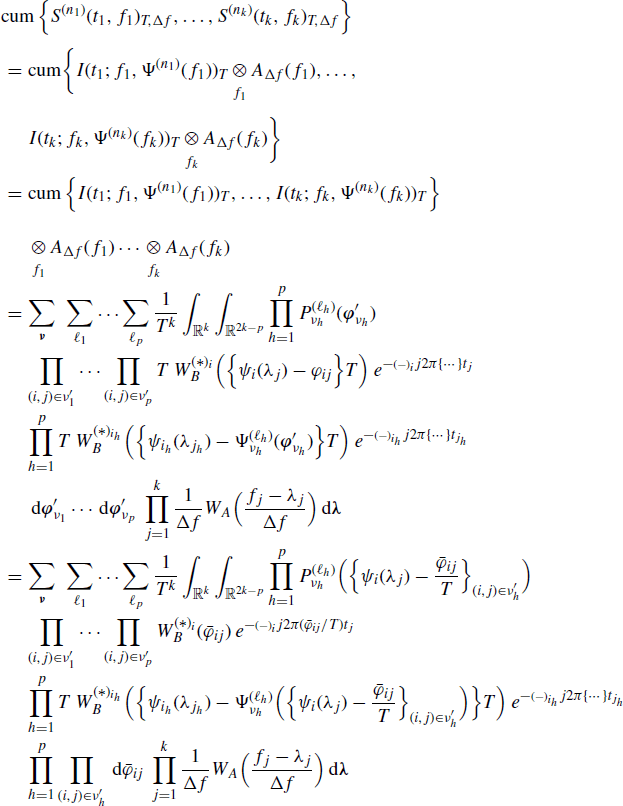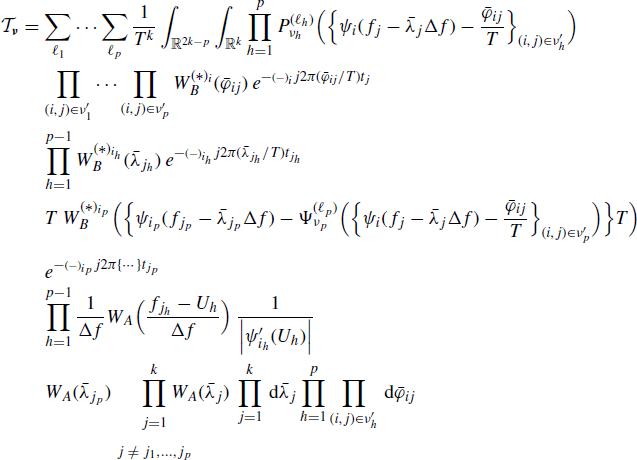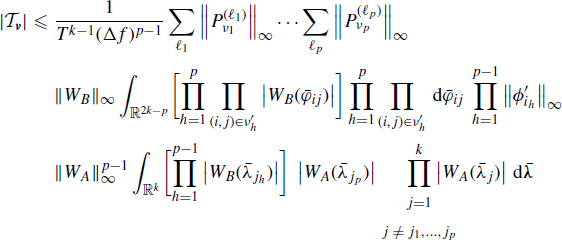5.6 Proofs for Section 4.7.2 “Asymptotic Normality of the Frequency-Smoothed Cross-Periodogram”
In this section, proofs of lemmas and theorems presented in Section 4.7.2 on the asymptotic complex Normality of the frequency-smoothed cross-periodogram are reported.
Fact 5.6.1
Let
(5.122) ![]()
where [*]i represents the ith optional complex conjugation, and let us consider the k × 2 table
and a partition of its elements into disjoint sets {ν1, …, νp}. The cumulant cum{Z1(f11, f21), …, Zk(f1k, f2k)} can be expressed as (Leonov and Shiryaev 1959), (Brillinger 1965), (Brillinger and Rosenblatt 1967)
where νm (m = 1, …, p) are subsets of elements of the k × 2 table (5.123), ![]() is the cumulant of the elements in νm, and the (finite) sum in (5.124) is extended over all indecomposable partitions of table (5.123), including the partition with only one element (see the discussion following (2.159) for details).
is the cumulant of the elements in νm, and the (finite) sum in (5.124) is extended over all indecomposable partitions of table (5.123), including the partition with only one element (see the discussion following (2.159) for details).
Let
(5.125) ![]()
The elements of the table (5.123) can be identified by the pair of indices (i, j), where i ![]() {1, 2} is the column index and j
{1, 2} is the column index and j ![]() {1, …, k} is the row index.
{1, …, k} is the row index.
From Assumption 4.7.8 it follows that
where ![]() is the vector with elements fij, (i, j)
is the vector with elements fij, (i, j) ![]() νm, the pair (im, jm) is one element (e.g., the last one) of the set νm, and
νm, the pair (im, jm) is one element (e.g., the last one) of the set νm, and ![]() is the vector containing the same elements as
is the vector containing the same elements as ![]() except (im, jm). Thus, it results that
except (im, jm). Thus, it results that ![]() .
.
In the sequel, the following notation will be used:
with elements of νm ordered from left to right and from top to bottom.
5.6.1 Proof of Lemma 4.7.10 Cumulants of Frequency-Smoothed Cross-Periodograms
Let us omit, for notation simplicity, the subscript yx(*) in ![]() ,
, ![]()
![]() , and
, and ![]() . Furthermore, in order to avoid heavy notation, the optional complex conjugations [*]i will be omitted. Results in the presence of these complex conjugations are similar.
. Furthermore, in order to avoid heavy notation, the optional complex conjugations [*]i will be omitted. Results in the presence of these complex conjugations are similar.
By substituting the STFT expression (4.94b) and (4.107) (with Δf = 1/T) into the cross-periodogram definition we formally have
(5.128) 
Thus, let
(5.129) ![]()
for the multilinearity property of cumulants (Mendel 1991) we have
(5.130) 
where, ϕ1 ![]() [ϕ11, …, ϕ1k], ϕ2
[ϕ11, …, ϕ1k], ϕ2 ![]() [ϕ21, …, ϕ2k],
[ϕ21, …, ϕ2k], ![]() . In the second equality (5.124) and (5.126) are accounted for; in the third equality the sampling property of Dirac delta is used and here and in the following (*)i = (*) if i = 1 and (*)i = (*) * if i = 2.
. In the second equality (5.124) and (5.126) are accounted for; in the third equality the sampling property of Dirac delta is used and here and in the following (*)i = (*) if i = 1 and (*)i = (*) * if i = 2.
Using again the multilinearity property of cumulants (Mendel 1991), the result is that
where, in the third equality Assumptions 4.4.5 (data-tapering window regularity) (with Δf = 1/T) and 4.6.2 (frequency-smoothing window regularity) are accounted for; and in the fourth equality the variable changes
![]()
are made in the inner integrals in ![]() (with λ fixed) so that, according to notation introduced in (5.127), the result is that
(with λ fixed) so that, according to notation introduced in (5.127), the result is that
![]()
Starting from the bounds derived in (5.133) and (5.138), the interchange of the order of cum, expectation, and integral operations can be justified by the Fubini and Tonelli theorem (Champeney 1990, Chapter 3). Furthermore, the same bounds justify the interchange of infinite sums and integral operations by the Weierstrass criterion (Smirnov 1964).
Let us consider the only term ![]() corresponding to the only partition with p = 1 in (5.131). The set ν1 is coincident with the whole rectangular k × 2 table and
corresponding to the only partition with p = 1 in (5.131). The set ν1 is coincident with the whole rectangular k × 2 table and ![]() with (i1, j1) = (2, k).
with (i1, j1) = (2, k).
(5.132) 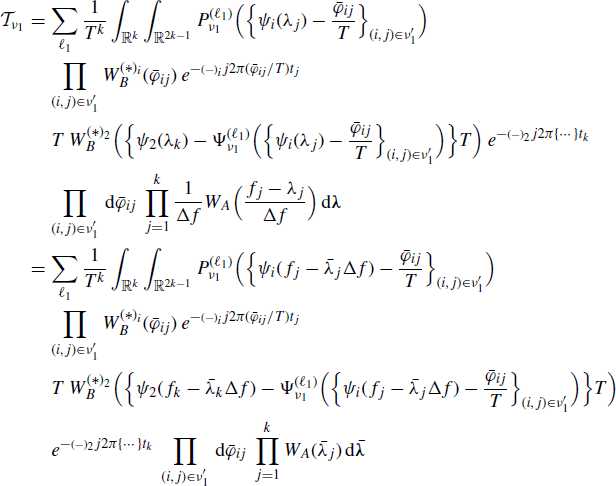
where ![]() and in the second equality the variable change
and in the second equality the variable change
![]()
(so that ![]() ) is made.
) is made.
Accounting for Assumptions 4.4.5 (data-tapering window regularity), 4.6.2 (frequency-smoothing window regularity), 4.7.8 (spectral cumulants), it results in
Therefore,
(5.134) 
and, hence,
(5.135) ![]()
The k × 2 table (5.123) has two columns and partitions are indecomposable (see comments following Assumption 2.4.15). Thus, for p ≥ 2 each set νm hooks with one or two other sets of the partition. Specifically, two sets (those containing at least one element of the first row or at least one element of the last row) hook with one set and the remaining p − 2 sets hook with two sets. Consequently, for p ≥ 2, each set νm has at least one line containing only one pair of indices. Let us choose as pair (im, jm) in Fact 5.6.1 the pair of indices corresponding to the lower of these lines of νm containing only one pair. Thus jm is a row index not shared with any other pair ![]() , where
, where ![]() is obtained by νm by removing the element (im, jm). The case is different for the only partition containing only one element (p = 1). In such a case, jm = k is a row index shared by (im, jm) = (2, k) with the element (1, k).
is obtained by νm by removing the element (im, jm). The case is different for the only partition containing only one element (p = 1). In such a case, jm = k is a row index shared by (im, jm) = (2, k) with the element (1, k).
Let us consider now the generic term ![]() with p > 1 in (1.131).
with p > 1 in (1.131).
Since p ≥ 2 and sets νh hook, we can select (ih, jh) so that no other pair ![]() has j = jh. Moreover, there are p − 1 distinct indices jh and jp = jp−1. Let us interchange the order of integrals
has j = jh. Moreover, there are p − 1 distinct indices jh and jp = jp−1. Let us interchange the order of integrals

and let us make the variable changes
![]()
Then, for h = 1, …, p − 1, order the integrals so that the innermost is that in ![]() and make the variable change
and make the variable change
![]()
(![]() fixed). Since no other pair
fixed). Since no other pair ![]() has j = jh, then
has j = jh, then
(5.136) ![]()
Thus,
where
![]()
Let ![]() denote the inverse function of
denote the inverse function of ![]() . It follows that
. It follows that ![]() is bounded due to Assumption 4.7.9. Thus,
is bounded due to Assumption 4.7.9. Thus,
That is,
(5.139) ![]()
with 2 ≤ p ≤ 2k. Hence
For k = 2 from (5.140), we have
(5.141) 
The above limit is bounded for all partitions ν with k = 2 only if the processes are zero mean. In fact, in such a case terms with p = 3 and p = 4 are identically zero (only terms with p = 1 and p = 2 are nonzero, see (5.11)). For k = 2 and zero-mean processes a tighter bound is provided by Theorems 4.7.7 and 5.8.2, for which
(5.142) ![]()
For k ≥ 3 from (5.140) we have
(5.143) ![]()
provided that the order of the two limits is not interchanged. In fact, for Δf finite, the limit as T→ ∞ is zero for k ≥ 3. In contrast, for T finite, since 2 ≤ p ≤ 2k, the limit as Δf → 0 is infinite for those partitions ν with p ≥ k/2 + 1.
The interchange of the order of integrals in the expression of ![]() to obtain (5.137) is justified by the Fubini and Tonelli theorem (Champeney 1990, Chapter 3). In fact, let
to obtain (5.137) is justified by the Fubini and Tonelli theorem (Champeney 1990, Chapter 3). In fact, let ![]() be Tk−1(Δf)p−1 times the integrand function in the expression of
be Tk−1(Δf)p−1 times the integrand function in the expression of ![]() in (5.137). One has
in (5.137). One has
(5.144) 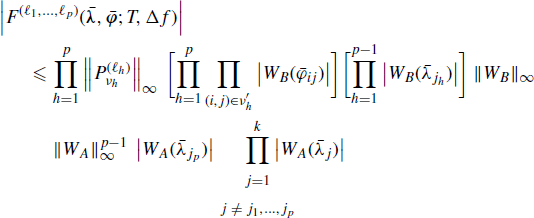
with the rhs belonging to ![]() due to Assumptions 4.4.5 (data-tapering window regularity) and 4.6.2 (frequency-smoothing window regularity).
due to Assumptions 4.4.5 (data-tapering window regularity) and 4.6.2 (frequency-smoothing window regularity).
5.6.2 Proof of Theorem 4.7.11 Asymptotic Joint Complex Normality of the Frequency-Smoothed Cross-Periodograms
From Theorem 4.7.6 it follows that
(5.145) ![]()
The rate of decay to zero of Δf should be such that ![]() approaches zero as T→ ∞ and Δf → 0 with TΔf→ ∞. Let us assume that
approaches zero as T→ ∞ and Δf → 0 with TΔf→ ∞. Let us assume that
(5.146) ![]()
with 0 < a < 1. Then, as T→ ∞, ΔfT = T−a → 0 with TΔfT = T1−a→ ∞. In addition, we have
(5.147) ![]()
Consequently, ![]() approaches zero as T→ ∞ provided that
approaches zero as T→ ∞ provided that
(5.148) ![]()
Therefore, the condition on a is
(5.149) ![]()
From Theorem 4.7.7 it follows that the asymptotic covariance
(5.150) 
is finite. Analogously, from Theorem 5.8.3 it follows that the asymptotic conjugate covariance is finite. Moreover, from Lemma 4.7.10 with k ≥ 3 we have
(5.151) 
Since the value of the cumulant does not change by adding a constant to each of the random variables (Brillinger 1981, Theorem 2.3.1), we also have
(5.152) 
That is, for every fixed ni, fi, ti, the random variables
![]()
i = 1, …, k, are asymptotically (T→ ∞ and Δf → 0 with TΔf→ ∞) zero-mean jointly complex Normal (Section 1.4.2).
![]()



